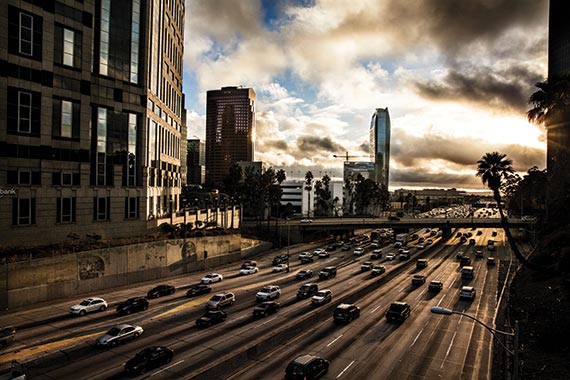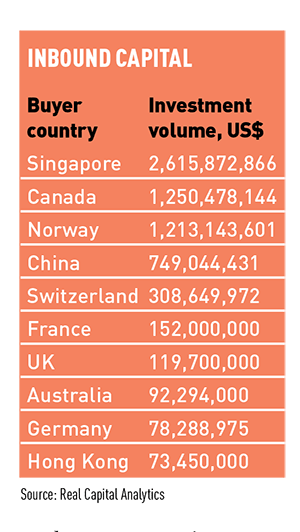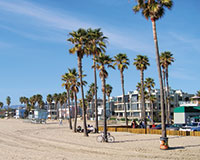
Hollywood. The place where “they will pay a thousand dollars for a kiss and 50 cents for your soul”, according to the late, great Marilyn Monroe. And she most likely had a point. The glitz and glamour of Los Angeles’s $100bn (£76bn) entertainment industry is what the city is best known for. But whether it has always painted the city in the best light is up for debate. Has it been lucrative? Absolutely. But, arguably, it has also left LA with a reputation for style over substance, as swathes of wannabe young actors descend each year, seduced by the slim possibility that they might be talent-spotted in a juice bar and become the world’s next biggest star.
But could all that be about to change? In the first quarter of this year, LA leapfrogged London to become the second-most active city in the world in terms of real estate investment. Racking up just over $7bn of sales, the city came second only to New York. And last year it bagged $42.4bn of investment – up by 27.1% year-on-year – putting it third globally after New York ($91.5bn) and London ($60.9bn), according to research by Real Capital Analytics.
“Our market is a gateway – there’s no question about that,” says Brad McCarthy, senior vice-president of capital markets at CBRE Southern California. “When international money is coming to the US, particularly from Asia, we’re always one of, if not the, top location on their list.”
But what makes this city, famous as much for its smog and traffic jams as its sunshine and surf, such an alluring investment prospect? Where is the money coming from and where is it going? In short, what makes LA a big-ticket blockbuster rather than a box-office flop?
Diverse economy
There is more attracting domestic and overseas investors than the Hollywood sparkle. Los Angeles County’s $700bn economy is strong, and remarkably diverse, with logistics and international trade, aerospace, banking and finance among its many industries.
So, too, is a growing high-tech research sector. Elon Musk’s Hyperloop and Oblong Technologies, both with offices in downtown, and Nasa’s Jet Propulsion Laboratory in Pasadena, are among the most exciting research facilities in the city
If LA County were a country, it would be the 20th-largest economy in the world, ahead of Belgium, Saudi Arabia, Norway and Taiwan.
Much of this is driven by infrastructure. While it is best known for the entertainment, tourism and fashion industries, LA is also home to the largest port complex in the western hemisphere, handling 40% of all containerised goods entering the US, and providing 524,000 manufacturing jobs – the largest number of any county in the country.
Los Angeles International is the third-busiest commercial airport in the US, and sixth-busiest in the world, handling almost 75m passengers last year – up by 6% on 2014. And an extensive network of arterial streets and dozens of freeways connect the city’s various centres of commerce, industry and tourism, with each other, the wider state and beyond.
In 2015, the number of jobs grew (by 2.2%), unemployment fell to its lowest rate in the post-recession period (6.9%), and personal income rose (by 4.5%), all of which are contributing to a thriving centre of opportunity that has not escaped the notice of the property industry.
Al Stemp, partner at Hogan Lovells’ Los Angeles office, says: “The LA real estate market has generally been very strong since 2012. I think that is when the hangover from the recession finally cleared up.”
According to CBRE’s McCarthy, two factors are driving the growth of LA’s commercial real estate market. The first is an influx of domestic ($35.5bn) and cross-border investment ($6.9bn), up by 11.4% and 101.4%, respectively. Cross-border activity includes an influx of global capital from Asia, Canada and Norway.
“For us, predominantly, that volume of money has come from China,” says McCarthy. “We are geographically closer to them than other places and we already have very established and large Chinese and Asian populations in our market. I think there is a comfort level with LA.”
The second reason is that this sun-soaked city is regarded as relatively cheap. “LA, if you compare it to New York and London, is inexpensive,” he says. “It’s viewed as a value buy opportunity where investors can place large amounts of capital and get a decent acquisition for their dollar.
“Our pricing has come a long way in the past five or six years. If you were to look 10 to 15 years out versus where the city is today, I think we are still very early on our curve, in terms of the city’s maturity on a global scale. If you were to continue to make those comparisons to the Londons and the New Yorks, I think we will still have a tremendous amount of opportunity in this market for investors.”
But in a volatile global economic market, best price is unlikely to be the only draw. Throw security into the mix and, suddenly, you have a real pull.
And the figures reflect the story. Cross-border market share jumped to 14.4%, up from 8.8% in 2014. And in the year to date for 2016, the figure has risen to 18.8%.
“People come here as a place to feel good about the preservation of capital,” says McCarthy. “They are not worried about having their entire investment wiped out in a short period of time.”
Downtown
Undoubtedly one of the most exciting areas of investment opportunity in Los Angeles is the city’s 5.84 square mile downtown, which is currently in the throes of a massive transformation.
This corner of the wider metropolitan area enjoyed a heyday in the early 20th century when the clustering of financial institutions led some to dub it the Wall Street of the West.
But post-war suburbanisation and increased car ownership saw investment diminish and the area fell into decline. Residents and businesses moved out and it became a ghost town outside of office hours as Angelinos hopped into their cars and headed for homes elsewhere.
That is not the downtown of today. The district is once again a hive of activity, accommodating more than half a million jobs and around 60,000 residents – a huge leap from the 27,849 people who lived there around the turn of the century.
In 1999, the City of Los Angeles passed the Adaptive Reuse Ordinance, which facilitated the conversion of dozens of historic and often vacant buildings into new housing units.
“This changed the planning paradigm in LA from suburban to urban. That was huge,” says Carol Schatz, president and chief executive of the Central City Association of Los Angeles and Downtown Center Business Improvement District. “Prior to that, LA did not have an urban focus.”
The turn of the millennium brought with it another pivotal change for downtown when the district of South Park became home to the 867,000 sq ft Los Angeles Convention Center, the 950,000 sq ft Staples Center (itself the base of a number of major sports teams, including the Lakers, Clippers, Kings and Sparks), and the 5.6m sq ft LA Live entertainment complex.
“The Lakers won three consecutive [basketball] championships from 2000, so all of the city’s pride around a sports team was focused on this area of town,” says John Zanetos, CBRE’s senior vice-president, brokerage services. “It did a lot of good for downtown LA.
“In addition to that, you had new developments coming out of the ground for multi-family residential product, both for sale and for lease. That allowed Angelinos to look at the area as no longer just a place for corporate business, but as a burgeoning new neighbourhood.”
Other key developments in downtown’s post-2000 renaissance include the 3,000-capacity post-modern architecture of the Cathedral of Our Lady of the Angels, which was unveiled in 2002 after a $250m, 14-year construction.
A year later, the striking curved steel of the Frank Gehry-designed Walt Disney Concert Hall was completed at a total cost of $274m ($110m was spent on building the underground parking alone), occupying a site that is the geographical centre of Los Angeles.
The rebirth of downtown’s arts district goes back much further. It got its name in the 1970s when artists began illegally colonising the millions of square feet of empty commercial and industrial space that was no longer deemed fit for purpose to create live-in studios.
In response, the City of Los Angeles created the “artist in residence” zoning variation ordinance in order to legalise these ad-hoc and often unsafe residences, and legitimate interest in the area grew.
The 1980s and 1990s saw around 20 large loft projects developed from industrial buildings with rents ranging from 65 to 75 cents per sq ft. After the year 2000, developers began converting large office buildings under a new “live/work” ordinance and rent climbed from around $1.10 per sq ft to around $2.50 per sq ft over the next 15 years as the purchase price of undeveloped buildings climbed.
Buildings such as the seven-storey West Coast headquarters of the National Biscuit Company became landmark sites in the regeneration of the district. Originally built for $2m in 1925, it underwent a $25m conversion into loft apartments in 2006 by Aleks Istanbullu Architects.
And where people go to live, food and drink businesses soon follow. Neighbourhood coffee shops, restaurants and bars began springing up among the newly developed loft apartments and converted warehouses to create a flourishing hospitality industry aimed squarely at the millennials making the arts district their home.
The downtown financial district was already a centre for business, accommodating the corporate offices of banking, law and real estate firms such as Wells Fargo, DLA Piper and CBRE. More than one-fifth of the people who work in this area also live in downtown LA.
Mixed-use developments featuring ground-level retail to create “walkable” streets, along with some combination of multi-family residential and office space, have become de rigueur in downtown.
The likes of Carmel Partners’ Eighth & Grand, a 700-home complex featuring a 41,000 sq ft Whole Foods, not only provides much-needed residential space, but also the sought-after amenities that urban lifestyles require.
 Gateway market
Gateway market
Another draw for investment comes from the fact that LA is the US gateway market for Asian investors. And when international real estate investors get comfortable on the West Coast, they generally stay put.
A general rule of thumb for international investment in US commercial real estate is that it tends to follow the major markets, says CBRE’s McCarthy.
“Recent historical experience has told us that especially with these large-scale investments, foreign capital tends to like to be in an A+ location,” he explains.
“International investors feel comfortable making a major investment in cities, even if they don’t know them intimately, because they know their interests will be protected by all the things that people like about big cities, such as high demand for product.”
And while it might seem like a negative, investors are also keen on high barriers to entry, says McCarthy. Strict environmental and zoning laws in California make it difficult to bring new projects to market in short time periods, so for the most part there is a reasonable supply and demand balance.
At the same time, investors know that major markets tend to have higher levels of demand for product, be it commercial, residential, retail or industrial space, and LA is no exception.
Average monthly asking rents in greater Los Angeles in the office and industrial sector have climbed steadily since 2012, rising by 20.2% to $2.91 per sq ft for offices and by 31.5% to 71 cents per sq ft for industrial in Q1 2016. Despite intermittent periods of decline, asking rents in retail also grew, rising by 15.6% to $2.37 per sq ft since 2012.
Ground-up
This strong demand for various asset classes is driving a predilection among Asian investors, particularly from Singapore, China, Hong Kong and Korea, for mixed-use projects.
Ground-up developments are currying particular favour and, thanks to the growing popularity of urban lifestyles, downtown is proving to be a hotspot.
Korean Air is halfway through the construction of Wilshire Grand, a 1,100ft skyscraper that will be the tallest building in LA as well as the tallest structure west of the Mississippi.
When complete, the $1bn development will also be home to 67,000 sq ft of shops, 677,000 sq ft of class-A office space and 900 hotel rooms, with InterContinental Hotels Group the operator.
Less than half a mile away, the US arm of China’s Greenland Group is building Metropolis, which is set to be the biggest mixed-use development on the West Coast. Set to complete in 2018, the $1bn scheme will comprise three towers featuring 1,500 condos and the 350-bedroom, 18-storey Hotel Indigo, a brand of IHG.
Another stone’s throw away, across the road from Staples Center, is a $900m mixed-use scheme that is being developed by Beijing-based Oceanwide Holdings. It comprises three high-rise towers, featuring 504 condos and a five-star, 183-bedroom hotel, sitting atop an eight-storey podium that houses 16,000 sq ft of shops and 1,440 parking spaces.
Appetite for construction in LA shows no signs of waning, intent as it is to follow the markets where demand is strong.
Stardom for Hollywood wannabes comes down to a wing and a prayer as much as talent and hard work, but considered investment in the Los Angeles real estate sector offers a promise of real returns.
The market
Offices
Around 2.3m sq ft of office space was under construction in the first quarter of 2016, reports CBRE, and the most active district is Hollywood, with 459,431 sq ft in the pipeline.
Net absorption of 611,086 sq ft is being driven by co-working companies, particularly downtown, while an influx of creative offices coming to market has also been reported, with almost 800,000 sq ft of new creative product made available in the last two quarters.
Like the city itself, the office market in greater Los Angeles is vast and varied.
“You’re talking about over 200m sq ft of space,” says CBRE senior vice-president, brokerage services, John Zanetos. “The two financial centres are downtown and Century City, but then you have a wide range of areas that are home to a mix of entertainment and technology companies that spans from Playa Vista to Venice, Santa Monica to Hollywood, Burbank and now the arts district.”
Head 350 miles north to Silicon Valley and you will find many of the world’s largest tech firms. But the increasing integration of content creation and online services has seen many of these companies, including YouTube, Netflix and Google, establish major outposts in LA.
Multi-family housing
Supply and demand in the residential market is much less balanced. Demand for housing in LA is fierce and mayor Eric Garcetti has called for 100,000 affordable homes to be built by 2021.
But while 26.5m sq ft of multi-family housing was being built in Q1 2016 – equating to nearly 26,000 units – the pace of new supply needs to quicken. Studies by Beacon Economics released in March found that between 2005 and 2015, permits were filed for only 21.5 units of housing for every 100 new residents of the state.
 Retail and leisure
Retail and leisure
It is a mixed picture for retail and leisure in greater LA. Vacancy rates rose by 20bps to 5.3% in Q1 2016, and there was negative net absorption of 157,828 sq ft, which to a degree was associated with the exit of grocery chain Haggen from the market.
But rents showed signs of improvement as Q1 2016 ended at $2.37 per sq ft, up by six cents, despite 440,372 sq ft of new retail product hitting the market.
Market trends in this sector have evolved significantly. Before the recession, retail development was scheduled around the planned growth in the Inland Empire (a region of southern California that includes Riverside and San Bernardino counties) and other emerging markets, says Jeff Moore, senior managing director of brokerage at CBRE.
But this strategy ran into trouble when downturn saw a lot of housing projects delayed or cancelled.
“Formerly the construction was out in the planned growth areas, in the Inland Empire going out east,” says Moore. “But now we’re seeing demand for revitalisation, new projects or revamping old projects and focusing on the urban core or close to the coast – where people want to live and where the highest densities are.”
Industrial
Falling vacancy rates and availability in the industrial market are beginning to affect activity levels. Net absorption was 1.3m sq ft, while 3.8m sq ft of industrial space was under construction, but direct vacancy was at 1.2% for the first quarter of 2016, down by 10 bps on the end of 2015.
Barbara Emmons, vice-chairman of capital markets at CBRE, says the fundamentals of the LA industrial real estate market are “as good as they’ve ever been”.
Fresh development land is scarce, while an aversion to the trucks associated with industrial real estate, paired with nimbyism, helps to make permits for new-builds hard to acquire.
“You’ve got land prices at all-time highs, vacancies at all-time lows, absorption that is very consistent because of a lot of tenant demand and you’ve got a really controlled environment,” says Emmons.
“Also fuelling this positive environment is e-commerce, which some cities really like because it generates more jobs and there is usually a point of sales tax associated with it. But you can’t do a development that only wants to have an e-commerce user because you don’t necessarily know they will come.”
Democratic rule
California is well known for being a Democratic stronghold, with the San Francisco Bay Area and Los Angeles dominating in the democratic, and liberal, stakes. But it has not always been the case.
The state was a Republican stronghold in presidential elections from 1952 until 1992. During this period, the Republicans won California in every election except the election of 1964. In these years, the party regularly nominated Californians as presidential candidates: Richard Nixon in 1960 and 1972, and Ronald Reagan in 1980 and 1984.
Since then however, the Democrats have carried the electoral-rich state since 1992. The immigration of Hispanic Americans and Asian Americans and migration of northern liberals, who tend to vote Democratic, and the flight of white, middle and upper-middle class suburbanites out of the state shifted the balance in favour of the Democratic Party.
The liberal mindset now known for characterising the state as a whole is prevalent in Los Angeles. So all eyes will be firmly on the progress of the US presidential candidates as we near the November election.
• To send feedback, email janie.stamford@estatesgazette.com or tweet @JanieStamford or @estatesgazette
LA SPECIAL











